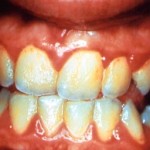Periodontal Disease
 It is a chronic infection of the gums which is characterized by a loss of attachment between the tooth and the jawbone. It is the leading cause of tooth loss among adults in the United States.
It is a chronic infection of the gums which is characterized by a loss of attachment between the tooth and the jawbone. It is the leading cause of tooth loss among adults in the United States.
Teeth are attached to the jaw by a series of very strong ligaments. The gums are also connected to the tooth by a complex series of microscopic fibers; and the gums lay over the tooth-bone attachment like a protective cover. Periodontitis begins in the shallow pocket where the tooth and gum meets, usually as a milder form of gum infection known as gingivitis. Bacteria can grow in this pocket, usually due to inadequate oral hygiene. The gum begins to pull away from the tooth deepening the pocket, making it harder to clean and encouraging the formation of tenacious tartar deposits below the gumline.
Not only is it the number one reason for tooth loss, research suggests that there may be a link between periodontal disease and other diseases such as, stroke, bacterial pneumonia, diabetes, cardiovascular disease, and increased risk during pregnancy. Researchers are determining if inflammation and bacteria associated with periodontal disease affects these systemic diseases and conditions. Smoking also increases the risk of periodontal disease.
Good oral hygiene, a balanced diet, and regular dental visits can help reduce your risk of developing periodontal disease.
Signs and symptoms of periodontal disease:
- Bleeding gums – Gums should never bleed, even when you brush vigorously or use dental floss.
- Loose teeth – Also caused by bone loss or weakened periodontal fibers (fibers that support the tooth to the bone).
- New spacing between teeth – Caused by bone loss.
- Persistent bad breath – Caused by bacteria in the mouth.
- Pus around the teeth and gums – Sign that there is an infection present.
- Receding gums – Loss of gum around a tooth.
- Red and puffy gums – Gums should never be red or swollen.
- Tenderness or Discomfort – Plaque, calculus, and bacteria irritate the gums and teeth.


